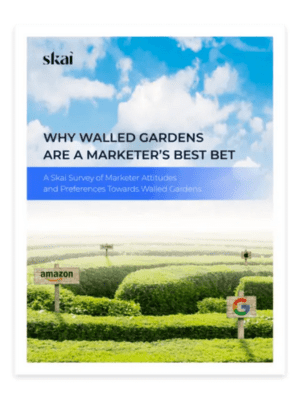
Joshua Dreller
Sr. Director, Content Marketing @ Skai

Joshua Dreller
Sr. Director, Content Marketing @ Skai

In our Skai 5 series, we discuss digital advertising tips, tricks, and trends to keep you one step ahead of consumers, market trends, and your competition. For this portion of the series, we highlighted the five benefits of walled garden media.
There’s an old proverb in marketing: advertisers vote with their wallets.
If that’s true, the fact that nearly four out of every five digital advertising dollars are now spent within walled gardens represents a landslide vote.
And it’s not just planned media budgets. 80% of marketers reported in our survey that if they were given a new, incremental budget in a quarter, much or some of it would likely go to performance media publishers. And at a time when CMO tenures are down, and pressure for marketing to drive business growth (not just vanity metrics) is at an all-time high, the spotlight is really on right now. Marketing has to be more and more accountable to outcomes in this context
When you consider the benefits of walled garden media, it’s no wonder why marketers prioritize it in their plans. Today, we examine five of these advantages.
One of the main reasons why most digital advertising spending goes to a short list of walled garden publishers is that marketers can reach nearly everyone on the planet without having to spread their efforts too thin. A marketer must place ads across hundreds or thousands of open web publishers to access the same audience size as just a handful of these publishers.
But, marketers want to work with as few partners as possible to reduce complexity, time, and costs.

With more limitations on third-party cookies and other common identifiers, brands realize that properly using their first-party datasets is key to adapting to the future. It’s filled with users that are already customers or web visitors and offers a competitive advantage because it’s a unique dataset your rivals don’t have. And, even better, once the (relatively low) cost to collect it is factored out, it’s free to use again and again without having to pay for each round like third-party segments.
Over the last two decades, walled garden publishers have built native tools for marketers to upload first-party data and use it to better target and personalize advertising.
Targeting the right ads to the right people online requires the right data. While third-party audience vendors offer segments for a price, walled garden publishers offer rich audience segments which marketers can use for free when targeting ads. Native segments are rich and robust based on users’ expressed or implicit preferences, behaviors, and characteristics.
They can also be combined into infinite combinations with each other as well as with first-party and third-party data segments.

The best marketing measurement is a holistic approach that can detect the impact and influence of all your paid and unpaid efforts on each other. And, while top-level assessment is ideal for understanding total media value, the cross-device measurement offered by walled garden publishers offers a precious view to optimize their individual programs.
So, while the CMO and advertising directors need omnichannel insights to plan and allocate budgets for annual media plans, channel practitioners can use intrachannel measurement to optimize elements daily within the publisher. Thus, by optimizing top-down at the media plan level and bottom-up at the channel level, marketers can ensure they improve results from both directions. This seems to be the best practice approach to drive the most performance.
Walled garden ads are inherently better suited to performance because of how well they simply sit within each publisher’s unique environment. For example, the search-triggered ads of Google and Amazon look and feel like search results listings and blend into the page. Meta and Instagram carousel ads offer users an expandable format to dive deeper into multiple brand messages without having to leave the page. Pinterest Promoted Pins, Snapchat Collection Ads, Apple Search Ads, etc., tend to have much higher response rates than the standard rectangles seen on most (non-walled garden) websites and apps.
Consumers have spoken: they prefer being marketed to on walled garden channels like retailer websites, search engines, social media, and app stores. And marketers have spoken: they need accountability for every dollar spent. That’s why we focus on the most effective ad channels for both sides of the equation — and bring them together for you.
Skai is the only omnichannel marketing platform for performance advertising. We’re helping marketers connect the walled gardens across retail media, paid search, paid social, and app marketing, making true omnichannel performance marketing a reality. Client results include:
New Skai report: Why walled gardens are a marketer’s best bet. 
The majority of U.S. digital advertising dollars are spent with walled garden publishers such as Google, Meta, Amazon, and Apple.
To better understand how marketers consider and use walled garden advertising now and in the future, Skai surveyed 117 U.S. marketing professionals. Questions included current and future spending trends, perceived strengths and weaknesses, and considerations for strategic decision-making.
We use cookies on our website. Some of them are essential, while others help us to improve this website and your experience.
Here you will find an overview of all cookies used. You can give your consent to whole categories or display further information and select certain cookies.